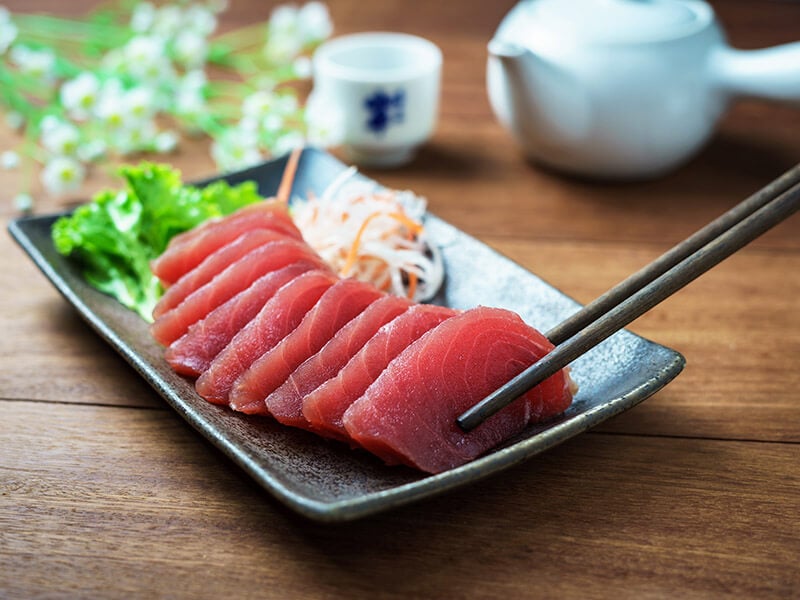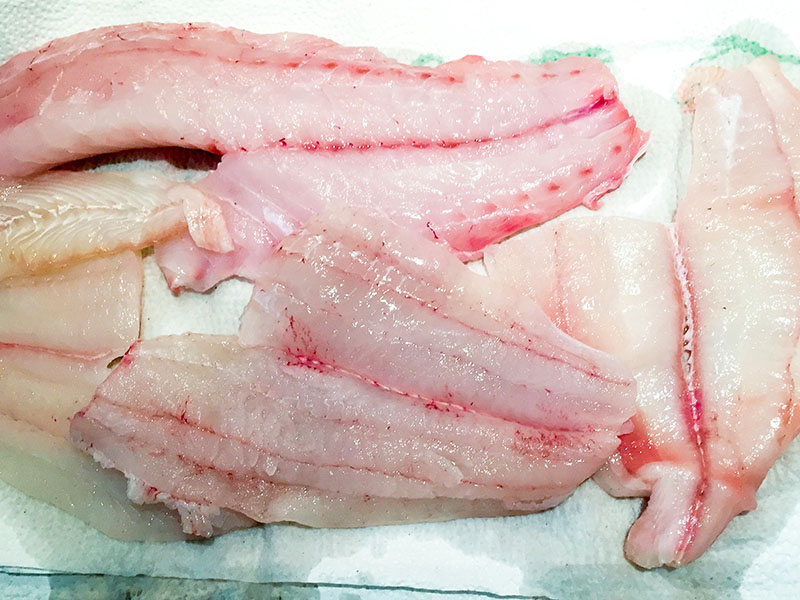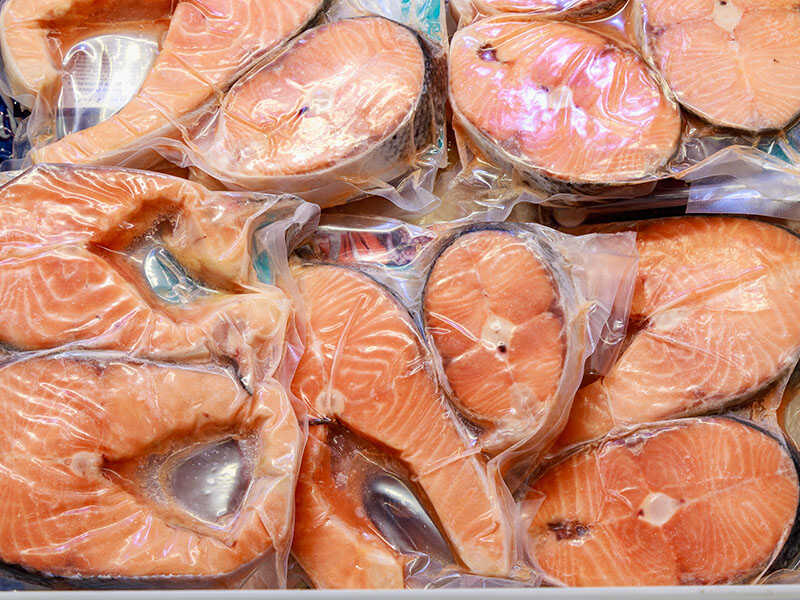Where should you store raw fish in a refrigerator? The answer is not anywhere. Raw fish is a delicate ingredient. It is easy to spoil, and the bacteria on it can even contaminate other foods in your fridge.
Food safety protocols are vital when it comes to handling fish. You need good preparation and placement for the fish to stay fresh and pristine until right before consumption.
Keep reading, as I am going to provide you with more information on how to store raw fish safely and effectively. Proper placement of raw fish can keep your fridge from smelling and retain their tasty flavors longer.

Types Of Raw Fish

It is a fact that fish holds many nutrition values that are vital to our health. If they are kept in storage properly after being caught, most of that nutrients can be preserved and the fish can still taste fresh coming out of the fridge after several days.
As long as the fish is kept fresh right before cooking, the flavors and nutrients won’t be affected too much. The difference in quality between freshly caught fish and flash-frozen fish from the local supermarket is negligible.
There are fish that can be served raw, and they are better raw. In contrast, there are fish that require cooking before they can be edible. For your clarity, I am going to classify them into smaller categories.
Edible Raw Fish

The fish market calls it sushi-grade, or sashimi-grade fish, one of the required ingredients for dragon roll sushi. “Sushi-grade” means that this fish is safe for raw consumption. Popular fish of this category include salmon, tuna, ahi tuna, halibut, Japanese mackerel, yellowtail, etc.
Most of the time, sushi-grade fish is caught fresh and sent to the store frozen to limit the risk of food-borne illness. They are expected to be consumed immediately after defrosting, as long as the methods used for defrosting fish follow food-safety regulations.
If somehow you manage to get your hands on a fresh and unfrozen sushi-grade fish and don’t intend to eat it any time soon, make sure to put it into the fridge as fast as possible.
Sushi-grade fish is the hardest category of fish to preserve. When their best-before date expires, it is better to cook them rather than to risk giving yourself food poisoning.
Raw Fish That Requires Cooking

Unless the fish you intend to eat is marked as sushi-grade, it is NOT ADVISABLE to eat them raw at all. These fish are always riddled with contaminants that sometimes can be fatal to consumers.
Fish of this category can include any fish that are not in the category above. The list consists of any common freshwater fish like catfish, trout, and sunfish, and most migratory fish and seawater fish like eels, anchovies, and other flatfish varieties.
Marinated Raw Fish

Raw fish that is marinated before cooking needs to be put in the fridge during marination. They should be put in a glass container or ziplock bag before storage. Be aware that the shelf life of marinated fish is only 2 hours in the fridge.
Where To Store Raw Fish In The Refrigerator

While it is easy to just chug the fish into the fridge and forget about it until mealtime, these actions have severe consequences. Here are some of my precautions and solutions to keeping the fish fresh in the refrigerator.
The rule of thumb is that fish, meat and poultry should always be stored at the bottom of the fridge, all the way in the back.
This rule applies to all types of fridges. So instead of sweating that you don’t know the main dissimilarities between side-by-side and French door fridges, you can simply tell yourself that the fish should stay at the fridge’s bottom, regardless of the fridge’s model.
For a more detailed description, the top-to-bottom order at the bottom layer is as follows:
- Whole fish
- Whole cuts of beef and pork
- Ground meat and fish
- Whole and ground poultry
The reason behind this is pretty simple. When you open the door of your fridge, the front will be the first to be affected by external temperature. Consequently, the temperature at the back of the fridge is the most stable.
You need to keep raw fish below most ingredients and ready-to-eat food. This is a precaution so that the liquid from the fish cannot come into contact with those foods. Any leakage may cause cross-contamination.
Cross-contamination occurs when bacteria change from one environment to another. This is one of the leading causes of contracting foodborne illnesses in humans. Side effects can include mild reactions like upset stomach to severe reactions like fever and even death.(2)
Fresh fish leaks a lot so it is better not to take any chances. Original packaging from the store does not fully prevent leaking. It is better to use airtight containers to store the fish.
What if you have no available airtight containers in the kitchen at the moment? A large and leak-proof defrosting tray will suffice. However, it’s best that you check the fish every so often to see if the water fills the tray. Nobody wants water leaking from fish to make a mess in the fridge.
This placement is also to ensure that the fish stays in the dark for longer. Any contact with light can speed up the spoiling rate of the fish.
If possible, you should buy fresh fish and finish it all in a day or two. This will ensure that the fish is of top-notch quality. It’ll also help you avoid crowding and increasing the overall weight of your fridge, especially if you tend to buy a lot of fish in one go.
However, there are some preparations you need to do before to make sure that the fish is ready to be in the refrigerator.
Things To Be Aware Of Before Storage
There are some steps that you need to take before the raw fish can go into the fridge. This is to ensure food safety and a means for you to keep your fish fresh and tasty for longer.
Choose Which Fish To Store

The first thing you need is for your raw fish to be fresh. The best fish to refrigerate is either freshly caught fish in the morning or frozen fish that has been kept cold from catch to the store.
These are the best candidates for your fridge because there are hardly any contaminants in the raw fish that could be detrimental to your health at that point. Parasites and bacteria require time to affect the quality of the fish.
If you are buying fish from the market or the store, pay attention to the smell and the outer appearance of the fish. Fresh fish does not have a strong smell, which you can notice right away.
Whole Fish
When buying whole fish, you should take a look at their eyes.
- Murky eyes mean that the fish has been dead for a long time. This also applies to premium fish like salmon. In fact, it’s one of the most telltale indications of spoiled salmon. Their flesh has already become soft and this type of fish is NOT for storage.
- Look for those with clear and bulging eyes. Pink and healthy-looking gills are also a good sign. These fish are guaranteed to be freshly caught and can last the longest in the fridge.
- Scales are also a good indication of how fresh the fish is. Run your hand along the body of the fish without too much force. If the scales remain attached to its skin, that fish is recently caught for sure.
Know the signs of fresh raw fish to store them in your fish.
Cut Fish

For cut fish and filets, which are lean cuts of fish, pay attention to the color and texture of the meat.
- Look for those with meat that has a slight sheen and is springy to the touch. The fresher the fish, the more vibrant the meat is.
- Do NOT buy cuts with meat that is dull and gray.
- It is also a good idea to look at the liquid coming out of the filets. Only choose those that have clear liquid. When the fish goes bad, this liquid will gradually turn from transparent to milky white.
The Temperature Is Important

The temperature of the fish is an important element for it to stay fresh. Contaminants require heat to grow and increase in number. This is why raw fish kept at cold temperature spoil way slower than fish kept at room temperature.
The fish stalls at the market are always packed with crushed ice because of this very reason. When you buy fresh fish, they are usually accompanied by some form of cold preservation method, either ice packs or cold packs.
This way, you make sure that the fish can stay cold from the market to your fridge. The only thing you need to worry about now is how and where to put the raw fish for the best outcome.
Basic Steps To Prepare Your Fish For Refrigeration
The process of storing fish includes 4 steps. You should follow it carefully to ensure food safety and prevent the fish from contaminating other foods inside the fridge.
Step 1: Sanitize Your Hands
Give your hands a quick rinse over cold water before handling the fish. This is to ensure no incidents of cross-contamination can occur.
Step 2: Remove The Fish From Its Original Packaging (Optional)
Frozen fish is often available with optimal packaging so they do not need to be repackaged. Just make sure to keep it cold until it is put into the fridge to ensure quality.
However, if you are dealing with fresh fish, you need to remove it from the wrapping. If it is a filet, give it a rinse to remove any contaminants from when it was cut.
Step 3: Dry With Paper Towels

Before you wrap them in anything again, however, make sure to dry them thoroughly with paper towels. Water is the conducive environment for bacteria to thrive, which means that the dryer you can get the fish, the longer it can keep.
Step 4: Wrap The Fish And Cool It With Ice
Grab some ice and crush it into smaller pieces. Wrap the ice in foil then place the fish on top with an aluminum sheet pan in-between. You need to make sure that the fish is not in direct contact with ice.
If you don’t have an aluminum sheet pan, plastic wrap or wax paper will do. Just make sure to cover all of the ice so that the fish only makes contact with the wrapping. Zip-top bags can also be a good choice. Just make sure to squeeze as much air out of the bags as you can.
A thin plastic wrap can be used to separate the fish and the ice.
If you want to make everything airtight, consider vacuum sealing. This option is great if you need to store the fish long-term. Frozen fish is a good choice for this method. Vacuum-sealed fish in the freezer can last for up to 2 years.
Here are some tips for you to vacuum-seal raw fish properly.
Do NOT pack all of the fish together. Wrap them individually to guarantee that the moisture of each bag does not find its way into another. Only line them up on one layer of the sheet pan to make sure that there is no risk of warm spots.
Tips To Keeping Your Fish Cold

You need to be aware of the temperature inside the fridge. Most refrigerators have a storage temperature of around 38 degrees F (3 degrees C), which is not enough for your fish to stay fresh. At this temp, your fish can degrade considerably after one night.
- The freezer can deal with this problem. However, it may create another. The freezing rate of a home freezer is too slow compared to the industrial flash-freezing method, which uses extremely low temperatures to preserve the fish quickly and naturally.
- The slow freezing can cause cell membranes to break down, consequently forming ice crystals in your fish that destroy its original texture. This is often called freezer burn. (1)
To solve this issue without the fish going into the freezer, ice is the solution. They can maintain raw fish at the optimal temperature of 32 degrees F (0 degrees C), which is enough for the fish to stay fresh, and for the tissues to not break apart from the cold.
How Long Can Raw Fish Stay Fresh
The recommended time to store fish is different based on the type of fish and how you intend to consume it. If left at room temperature, raw fish will begin to spoil after 2 hours.
- Fresh mackerels, bluefish, and sardines can only stay fresh in the fridge for 3 days.
- Fresh tuna, trout, flounder, salmon, bass, and swordfish can be kept for 3-5 days.
For more detailed information, you can refer to the summary table below. Keep in mind that this is only relative and you should always check the fish one last time before handling it.
If you intend to keep any of these fish for a longer amount of time, it is best to put them in a freezer. The quality will decrease, but it is a better choice than the risk of food-borne diseases.
Frozen fish from the store often comes with an expiration date. You can use it as a guide to know how long you can keep the fish before it goes bad. However, many elements can cause fish to spoil faster.
You can extend the expiration date by keeping the fish frozen until you put it in your home freezer. Because the fish hasn’t been defrosted and contaminated, it can stay fresh for longer.
Fatty fish like tuna and salmon can stay frozen like that for 2-3 months before there are signs of spoilage. Lean fish like tilapia, however, are more forgiving and can remain good in your freezer for 6 months

You can also manually label the date of storage, or date of expiration, on each fish to ensure that no fish is left past their due expiration.
It is always better to inspect the fish yourself before cooking. Use your natural senses to check for signs of fish going bad like a bad smell or discoloration on the meat. Any changes mean that the fish has gone bad already and you should not eat it.
FAQs
Got more questions related to how raw fish should be stored in the refrigerator? Don’t worry, here are the answers to some of the commonly asked questions about raw fish.
A Quick Reminder
Freshness is the most important element that decides how long raw fish can keep inside your refrigerator. Always choose recently caught fish or frozen fish to ensure both flavor and quality.
Always store raw fish individually and below other foods in your fridge. You should place the fish at the back of the fridge to prevent light and temperature from affecting the fish every time you open and close the door.
I’m sure you have all the needed information to know where you should store raw fish in a refrigerator. If you find this article useful, don’t be afraid to leave a comment and share your experience with me and others.

References
- Healthline. 2021. Freezer Burn: Why It Happens and Tips to Prevent It.
- Healthline. 2021. What Is Cross Contamination? Plus, How to Avoid It.






